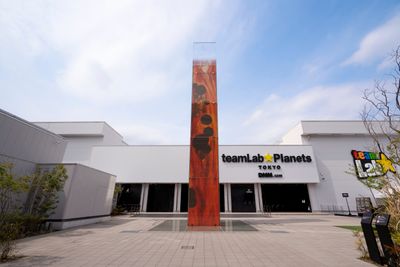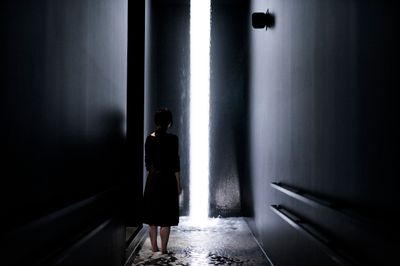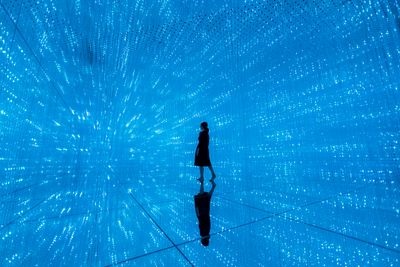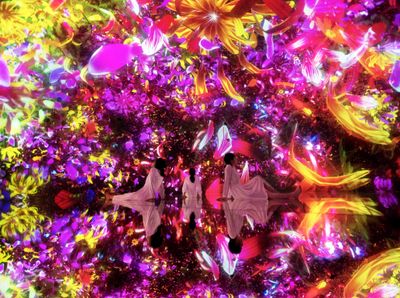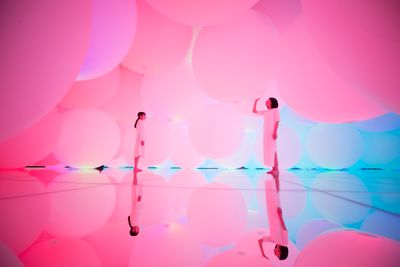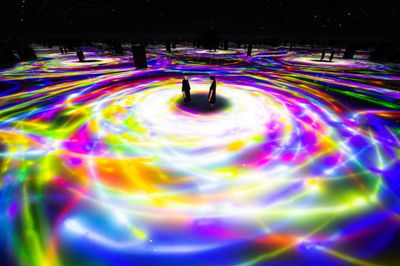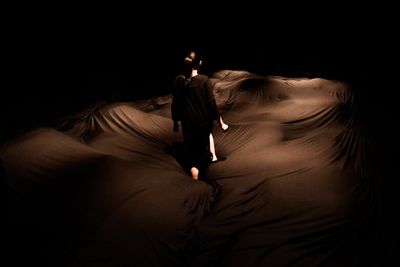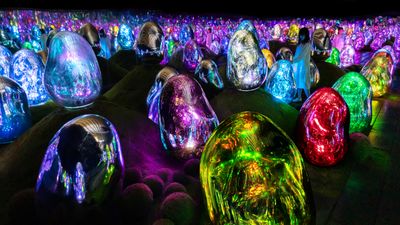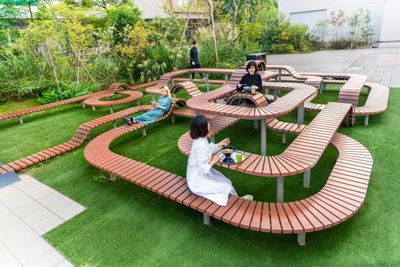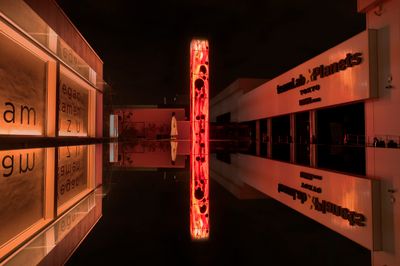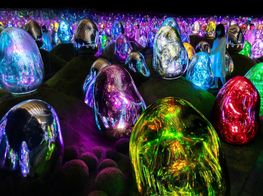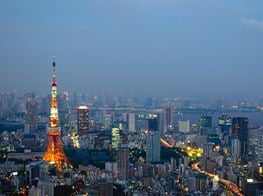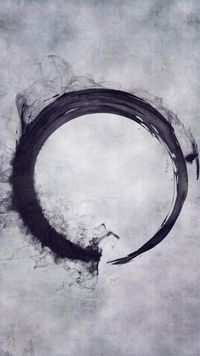teamLab Planets TOKYO Is a Phenomenon. But What Is It?
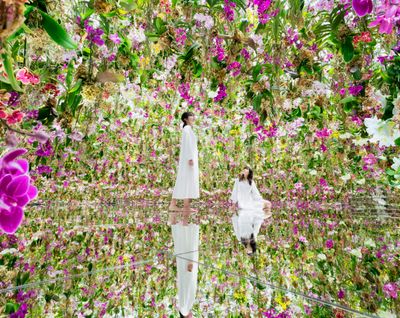
teamLab, Floating Flower Garden; Flowers and I are of the Same Root, the Garden and I are One (2015). Interactive Kinetic Installation, Endless, Sound: Hideaki. Takahashi Orchids (except Vanda and Renanthera): Haruyuki Kato (Zama Orchids Center). Vanda and Renancera: Kazuki Kaneta (moku), Yoshinobu Ueda (ACRE8), teamLab. © teamLab, courtesy Pace Gallery.
The wildly popular attraction is hard to categorise, wavering between an art museum and a theme park. In that respect, it reflects the people behind it. teamLab describe themselves as an art collective, but what makes them most interesting is the ways in which they overflow that identity.
Almost one in ten visitors to Japan come through teamLab Planets TOKYO, the collective's immersive experience in Toyosu, an island of reclaimed land that's home to the city's wholesale fish market.
A long line of people snakes back and forth in front of the entrance, some with umbrellas popped against the sun, when teamLab's communications director Takashi Kudo arrives to rescue me from the 37-degree heat.
Kudo is a character. His head is shaved except for two braids, the longer one dreadlocked in place, the shorter swinging freely. A self-described hippie, Kudo says he was homeless around Asia, the Middle East, and Europe for six years before landing a job as the editor-in-chief of a gaming magazine in Sweden. (Video games are coded into teamLab's brand identity—Kudo says their logo, with its primary colours and prominent yellow star, was in part inspired by Nintendo.) When he returned to Japan in 2009, his friends at teamLab said they were lacking a communications director, and offered him the role.
Kudo escorts me inside and we remove our shoes. Our interview begins as we ascend a ramp running with water to an illuminated waterfall, and continues as we move through vines of multi-coloured LED lights, a pond of projected-light fish that swim around our legs, a dome of digital flowers, and shifting walls of lush, live orchids, among other enticements.
Some installations are reminiscent of works by other artists. The LED vines of The Infinite Crystal Universe—which are installed in a room with mirrored walls, floor, and ceiling—recall Yayoi Kusama's 'Infinity Mirror' rooms (c. 1965–ongoing). teamLab have taken the idea further, however, with lights illuminating and changing colours in sophisticated pre-programmed patterns whose expressions are influenced by the presence and position of viewers. Different patterns can be initiated by viewers at control panels in the space, or by using the teamLab app.
Similarly, the dome of brightly coloured digital flowers, Floating in the Falling Universe of Flowers (2016), recalls Pipilotti Rist's sensual video installations, but the scale is greater, with countless buds blooming and exploding into their composite stems and petals, and new flowers spawning as the seasons change.
Most striking about the experience is how well designed it is. Crowds flow through teamLab Planets seamlessly. After chasing the digital fish, for example, visitors collect a towel at one end of the room to dry their feet and deposit it in a bin at the other end as they move on to the next installation.
teamLab describe themselves as an 'international art collective' on their website, and much of what they do falls in line with what contemporary artists do. Takashi Murakami invited them to give their first international art exhibition at Kaikai Kiki Gallery in Taipei in 2011, and they went on to participate in the Singapore Biennale from 2013 to 2014. Their work Ever Blossoming Life—Gold (2014) sold at Christie's New York in May 2018 for U.S. $225,000, and they are now represented by global mega-gallery Pace, Sydney's Martin Browne Contemporary, and Singapore's Ikkan Art.
Kudo says he would sometimes be frustrated by those who didn't see teamLab as a real art collective, but now not so much. There was a criticism in Japan that they make software, something you can't see or touch, so it's not real art. You can't have it. 'Have' is a word that mystifies Kudo. He has kids, he says, but doesn't own them. He had a mother who died of cancer, but he is still her son.
Digital art is becoming more established every year, and even the notion that you can't 'have' digital assets has been overturned by the rise in popularity of NFTs. There's no doubt in my mind that teamLab is an art collective, but they are also a 'software and design collective' as WIRED described them in 2017, and an 'ultra-technologist group' as they described themselves in an interview for a Harvard Business School case study the same year. They comprise both an art collective and a digital solutions agency, as evidenced by their other website, and while these two parts of teamLab largely operate independently, a design mentality deeply informs their artwork.
teamLab was established in 2001 by Toshiyuki Inoko—while he was still completing graduate studies in probability and statistical modelling—along with Daisuke Sakai, Tetsuya Tamura, Yuzuru Yoshimura, and Shunsuke Aoki, who left to start his own company in 2007. (Kenichi Watanabe has since joined as a director.) Inoko leads teamLab's art activities and Sakai leads their digital solutions work, which includes website development, system integration, app development, UI, and UX. A third division of the company, teamLab Architects, is credited with designs for offices, retail spaces, restaurants, and more.
teamLab does not share its total number of members, preferring to emphasise the diversity of their skillsets, but it appears they have more than doubled in size from the 400 members they had in 2017. They would not confirm the exact number of staff, how many are devoted to making art, nor what portion of their revenue the art business generates.
teamLab's artwork, like much of their digital solutions work, follows a design process that seeks to identify and solve problems. In a short concept essay published in 2001, teamLab noted that 'for the majority of art up until now, the presence of other viewers tends to constitute a hindrance.' In response, they proposed immersive digital artworks that can be viewed from many different perspectives, and respond to viewers. Instead of obscuring an artwork, other viewers help bring it to life.
The way teamLab is structured is also meant to solve a problem. According to Inoko, management kills creativity. For that reason, Sakai told researchers from Harvard Business School, 'we manage the company by not managing it.' teamLab has little hierarchy and avoids job titles, business plans, and sales targets. Projects are managed by 'catalysts' who recruit staff internally for the projects they want to work on. Individual performance is determined by colleagues' assessments of how yabai (freaking awesome) they are.
Kudo is similarly hands-off with his instructions to me. 'Write whatever you want,' he emphasises, though when I ask about teamLabs' projects in development and the corporations partnering on them he says some things he tells me 'can't go in my article'. teamLab, who are deeply thoughtful about their brand, follow up with a thorough fact check and some gentle massaging of terms — they prefer 'solutions' to 'client work', for instance, and note that Kudo doesn't really have a job title, but communications director will suffice if needed.
We can say that teamLab Planets is a co-production with DMM.com, a Japanese company that earned 347.6 billion yen (U.S. $2.44 billion) in the 2022 fiscal year across their myriad offerings, which include online shopping, English language schools, anime, gaming, 3D printing, and horse racing.
teamLab Planets was established in 2018, just two weeks after teamLab Borderless, the collective's first digital art museum, opened on nearby Odaiba island. Borderless was produced with Japanese property development and management giant Mori Building, the same company behind Tokyo's Mori Art Museum. In its first year, 2.3 million people visited Borderless, making it the most popular single-artist museum on the planet, ahead of the Van Gogh Museum in Amsterdam.
teamLab Borderless is currently closed, but it is slated to reopen in Mori's Azabudai Hills development in central Tokyo in January next year. teamLab's other permanent locations include teamLab Borderless Shanghai, teamLab SuperNature Macao, and teamLab Massless Beijing, with more to come in Abu Dhabi, Hamburg, Jeddah, and Utrecht.
teamLab is expanding quickly, and there's an almost messianic, utopian bent to their work. It seeks to bring people together in a way that enhances everyone's experience. With harmony as a core motivation, it is extremely rare to read the names of all of teamLab's directors, and credit for any one idea is rarely attributed to an individual.
The work that most speaks to teamLab's philosophy is Floating Flower Garden: Flowers and I are of the Same Root, the Garden and I are One (2015). The garden is a bright, sunny room containing over 13,000 live orchids. The orchids cling to wires attached to the ceiling that elevate and lower them in curtains, allowing viewers to scooch under them, move further into the room, and be fully surrounded by flowers.
Kudo relates that flowering plants were the last to evolve on Earth, but thanks to their diversity, they now constitute the vast majority of plant species. Orchids are especially remarkable, both for their diversity—making up around ten percent of all plant species—and their ability to live in harmony with the insects that help pollinate them. Most don't even compete for space in the soil, growing happily on rocks, or attached to other plants.
We often imagine an artist not as a small part of a bigger ecosystem but as a lone genius inspired by their particular circumstances, thoughts, and feelings to bring their vision to life. Returning to video games, Hidetaka Miyazaki is among the genre's most celebrated auteurs, having overseen Elden Ring (2022), something he has described as 'very close to my ideal game'. Elden Ring evolved from Demon's Souls (2009), a game Miyazaki took on precisely because no one expected it to succeed. 'I figured if I could find a way to take control of the game, I could turn it into anything I wanted,' he told The Guardian in 2015.
Answering to no one, and pursuing a personal vision is also one way to succeed as an artist. But surely the ways people make art should be diverse, as rich in variety as species of orchids. teamLab's collective, design-brand-inflected approach is distinctive, and yields its own distinctive kind of art experiences.
If, in spite of their overwhelming popularity and ostensible financial success, teamLab ever decides their artistic process is in some way a problem, they're exactly the right people to design a solution. —[O]

